Role of Nanofluid and Hybrid Nanofluid for Enhancing Thermal Conductivity towards Exponentially Stretching Curve with Modified Fourier Law Inspired by Melting Heat Effect
Abstract
1. Introduction
- (i)
- How does the curving surface’s curvature affect the dust stage movement?
- (ii)
- What role does the solid volume part play in the dust and flowing phases?
- (iii)
- How does the thermal relaxation factor affect the fluid temperature?
- (iv)
- What is the effect of the slippage?
- (v)
- How liquidity, speed, and heat are impacted by the curvature of the sheet?
- (vi)
- Which type of nanofluid is most dominant?
- (vii)
- How does fluid velocity connect to the molten heat phenomenon?
2. Mathematical Modulation
2.1. For Nanoliquid
2.2. For Dusty Liquid
3. Introducing the Similarity Transformation
3.1. For Nanoparticles Fluid
3.2. For Dusty Fluid Flow
4. Error Explanation
5. Analysis and Results
6. Concluding Remarks
- It is observed that the dust-phase velocity is improved when is augmented.
- It is examined that the velocity profile is increased with the increasing values of while the phase-density velocity declines with growing values of .
- When compared to the thermal relaxation factor, the temperature of the liquid decreases.
- Similarly, for each of the liquid and dusty phases, rising and diminishing tendencies can be detected in the motion and thermal profiles against the curvature factor.
- The efficiency of the hybrid nanofluid is much better than that of the conventional nanofluid.
- The first-order slip factor, the curved factor, and the dragging force component all have increasing effects on the velocity field DPV, temperature field, and DPT. However, it decreases for the second-order slippage factor.
Author Contributions
Funding
Data Availability Statement
Acknowledgments
Conflicts of Interest
References
- Choi, S.U.; Eastman, J.A. Enhancing Thermal Conductivity of Fluids with Nanoparticles; No. ANL/MSD/CP-84938, CONF-951135-29; Argonne National Lab.: Chicago, IL, USA, 1995. [Google Scholar]
- Buongiorno, J. Convective transport in nanofluids. J. Heat Transfer. 2006, 128, 240–250. [Google Scholar] [CrossRef]
- Rafati, M.; Hamidi, A.; Niaser, M.S. Application of nanofluids in computer cooling systems (heat transfer performance of nanofluids). Appl. Therm. Eng. 2012, 45-46, 9–14. [Google Scholar] [CrossRef]
- Xian, H.W.; Sidik, N.A.C.; Najafi, G. Recent state of nanofluid in automobile cooling systems. J. Therm. Anal. Calorim. 2019, 135, 981–1008. [Google Scholar] [CrossRef]
- Sheikhpour, M.; Arabi, M.; Kasaeian, A.; Rokn Rabei, A.; Taherian, Z. Role of nanofluids in drug delivery and biomedical technology: Methods and applications. Nanotechnol. Sci. Appl. 2020, 13, 47. [Google Scholar] [CrossRef] [PubMed]
- Nagarajan, P.; Subramani, J.; Suyambazhahan, S.; Sathyamurthy, R. Nanofluids for solar collector applications: A review. Energy Procedia 2014, 61, 2416–2434. [Google Scholar] [CrossRef]
- Motsumi, T.G.; Makinde, O.D. Effects of thermal radiation and viscous dissipation on boundary layer flow of nanofluids over a permeable moving flat plate. Phys Scr. 2012, 86, 045003. [Google Scholar] [CrossRef]
- Saidur, R.; Leong, K.; Mohammed, H. A review on applications and challenges of nanofluids. Renew. Sustain. Energy Rev. 2011, 15, 1646–1668. [Google Scholar] [CrossRef]
- Wong, K.V.; De Leon, O. Applications of nanofluids: Current and future. Adv. Mech Eng. 2010, 2, 519659. [Google Scholar] [CrossRef]
- Kumar, M.D.; Raju, C.S.K.; Sajjan, K.; El-Zahar, E.R.; Shah, N.A. Linear and quadratic convection on 3D flow with transpiration and hybrid nanoparticles. Int. Commun. Heat Mass Transfer 2022, 134, 105995. [Google Scholar] [CrossRef]
- Sandeep, N.; Ranjana, B.; Samrat, S.; Ashwinkumar, G. Impact of nonlinear radiation on magnetohydrodynamic flow of hybrid nanofluid with heat source effect. Proc. Inst. Mech. Eng. E J. Process Mech Eng. 2022, 236, 1616–1627. [Google Scholar] [CrossRef]
- Samrat, S.; Ashwinkumar, G.; Sandeep, N. Simultaneous solutions for convective heat transfer in dusty-nano-and dusty-hybrid nanoliquids. Proc. Inst. Mech Eng. E J. Process Mech. Eng. 2021, 236, 09544089211043605. [Google Scholar] [CrossRef]
- Chalavadi, S.; Madde, P.; Naramgari, S.; Poojari, A.G. Effect of variable heat generation/absorption on magnetohydrodynamic sakiadis flow of casson/carreau hybrid nanoliquid due to a persistently moving needle. Heat Transfer. 2021, 50, 8354–8377. [Google Scholar] [CrossRef]
- Abderrahmane, A.; Qasem, N.A.A.; Younis, O.; Marzouki, R.; Mourad, A.; Shah, N.A.; Chung, J.D. MHD Hybrid Nanofluid Mixed Convection Heat Transfer and Entropy Generation in a 3-D Triangular Porous Cavity with Zigzag Wall and Rotating Cylinder. Mathematics 2022, 10, 769. [Google Scholar] [CrossRef]
- Ashraf, M.Z.; Rehman, S.U.; Farid, S.; Hussein, A.K.; Ali, B.; Weera, W. Insight into significance of bioconvection on MHD tangent hyperbolic nanofluid flow of irregular thickness across a slender elastic surface. Mathematics 2022, 10, 2592. [Google Scholar] [CrossRef]
- Lou, Q.; Ali, B.; Rehman, S.U.; Habib, D.; Abdal, S.; Chung, J.D. Micropolar dusty fluid: Coriolis force effects on dynamics of MHD rotating fluid when lorentz force is significant. Mathematics 2022, 10, 2630. [Google Scholar] [CrossRef]
- Ashwinkumar, G.P. Heat and mass transfer analysis in unsteady MHD flow of aluminium alloy/silver-water nanoliquid due to an elongated surface. Heat Transfer. 2021, 50, 1679–1696. [Google Scholar] [CrossRef]
- Ashwinkumar, G.P.; Samrat, S.P.; Sandeep, N. Convective heat transfer in MHD hybrid nanofluid flow over two different geometries. Int. Commun. Heat Mass Transfer. 2021, 127, 105563. [Google Scholar] [CrossRef]
- Ragupathi, P.; Ahammad, N.A.; Wakif, A.; Shah, N.A.; Jeon, Y. Exploration of Multiple Transfer Phenomena within Viscous Fluid Flows over a Curved Stretching Sheet in the Co-Existence of Gyrotactic Micro-Organisms and Tiny Particles. Mathematics 2022, 10, 4133. [Google Scholar] [CrossRef]
- Tlili, I.; Nabwey, H.A.; Samrat, S.P.; Sandeep, N. 3D MHD nonlinear radiative flow of CuO-MgO/methanol hybrid nanofluid beyond an irregular dimension surface with slip effect. Sci. Rep. 2020, 10, 1–14. [Google Scholar] [CrossRef]
- Alotaibi, H.; Althubiti, S.; Eid, M.R.; Mahny, K.L. Numerical treatment of mhd flow of casson nanofluid via convectively heated non-linear extending surface with viscous dissipation and suction/injection effects. Comput. Mater. Continua. 2020, 66, 229–245. [Google Scholar] [CrossRef]
- Yu, B.; Ramzan, M.; Riasat, S.; Kadry, S.; Chu, Y.-M.; Malik, M.Y. Impact of autocatalytic chemical reaction in an Ostwald-de-Waele nanofluid flow past a rotating disk with heterogeneous catalysis. Sci. Rep. 2021, 11, 1–17. [Google Scholar] [CrossRef] [PubMed]
- Shaheen, N.; Ramzan, M.; Alshehri, A.; Shah, Z.; Kumam, P. Soret–Dufour impact on a three-dimensional Casson nanofluid flow with dust particles and variable characteristics in a permeable media. Sci. Rep. 2021, 11, 1–21. [Google Scholar] [CrossRef]
- Bilal, M.; Ramzan, M.; Mehmood, Y.; Alaoui, M.K.; Chinram, R. An entropy optimization study of non-Darcian magnetohydrodynamic Williamson nanofluid with nonlinear thermal radiation over a stratified sheet. Proc. Inst. Mech. Eng. E J. Process Mech. Eng. 2021, 235, 1883–1889. [Google Scholar] [CrossRef]
- Ramesh, G.; Madhukesh, J.; Shah, N.A.; Yook, S.-J. Flow of hybrid CNTs past a rotating sphere subjected to thermal radiation and thermophoretic particle deposition. Alexandria Eng. J. 2022, 64, 969–997. [Google Scholar] [CrossRef]
- Bashir, S.; Ramzan, M.; Chung, J.D.; Chu, Y.-M.; Kadry, S. Analyzing the impact of induced magnetic flux and Fourier’s and Fick’s theories on the Carreau-Yasuda nanofluid flow. Sci. Rep. 2021, 11, 1–18. [Google Scholar] [CrossRef]
- Ma, Y.; Mohebbi, R.; Rashidi, M.M.; Yang, Z. Study of nanofluid forced convection heat transfer in a bent channel by means of lattice Boltzmann method. Phys. Fluids 2018, 30, 032001. [Google Scholar] [CrossRef]
- Zeeshan, K.; Ahammad, N.A.; Shah, N.A.; Chung, J.D.; Rasheed, H.U. Analysis of Error and Stability of Nanofluid over Horizontal Channel with Heat/Mass Transfer and Nonlinear Thermal Conductivity. Mathematics 2023, 11, 690. [Google Scholar] [CrossRef]
- Riasat, S.; Ramzan, M.; Sun, Y.-L.; Malik, M.; Chinram, R. Comparative analysis of Yamada-Ota and Xue models for hybrid nanofluid flow amid two concentric spinning disks with variable thermophysical characteristics. Case Stud. Therm. Eng. 2021, 26, 101039. [Google Scholar] [CrossRef]
- Rasheed, H.U.; Khan, W.; Khan, I.; Alshammari, N.; Hamadneh, N. Numerical computation of 3D Brownian motion of thin film nanofluid flow of convective heat transfer over a stretchable rotating surface. Sci. Rep. 2022, 12, 1–14. [Google Scholar]
- Khan, Z.; Rasheed, H.U.; Khan, I.; Abu-Zinadah, H. and Aldahlan, M.A. Mathematical Simulation of Casson MHD Flow through a Permeable Moving Wedge with Nonlinear Chemical Reaction and Nonlinear Thermal Radiation. Materials 2022, 15, 747. [Google Scholar] [CrossRef] [PubMed]
- Waini, I.; Ishak, A.; Pop, I. Hybrid nanofluid flow past a permeable moving thin needle. Mathematics 2020, 8, 612. [Google Scholar] [CrossRef]
- Khan, I.; Weera, W.; Mohamed, A. Heat transfer analysis of Cu and Al2O3 dispersed in ethylene glycol as a base fluid over a stretchable permeable sheet of MHD thin-film flow. Sci. Rep. 2022, 12, 1–4. [Google Scholar]
- Zhang, Y.; Shahmir, N.; Ramzan, M.; Alotaibi, H.; Aljohani, H.M. Upshot of melting heat transfer in a Von Karman rotating flow of gold-silver/engine oil hybrid nanofluid with cattaneo-christov heat flux. Case Stud. Therm. Eng. 2021, 26, 101149. [Google Scholar] [CrossRef]
- Bilal, M.; Arshad, H.; Ramzan, M.; Shah, Z.; Kumam, P. Unsteady hybrid-nanofluid flow comprising ferrousoxide and CNTs through porous horizontal channel with dilating/squeezing walls. Sci. Rep. 2021, 11, 1–16. [Google Scholar] [CrossRef]
- Chung, J.D.; Ramzan, M.; Gul, H.; Gul, N.; Kadry, S.; Chu, Y.-M. Partially ionized hybrid nanofluid flow with thermal stratification. J. Mater. Res. Technol. 2021, 11, 1457–1468. [Google Scholar] [CrossRef]
- Gul, T.; Kashifullah; Bilal, M.; Alghamdi, W.; Asjad, M.I.; Abdeljawad, T. Hybrid nanofluid flow within the conical gap between the cone and the surface of a rotating disk. Sci. Rep. 2021, 11, 1–19. [Google Scholar] [CrossRef] [PubMed]
- Baron Fourier, J.B.J. Theories an Alytique de la Chaleur; Chez Firmin Didot, Père et Fils: Paris, France, 1822. [Google Scholar]
- Cattaneo, C. Sulla conduzione del calore. Atti. Sem. Mat. Fis. Univ. Modena. 1948, 3, 83–101. [Google Scholar]
- Christov, C.I. On frame indifferent formulation of the Maxwell–Cattaneo model of finite-speed heat conduction. Mech. Res. Commun. 2009, 36, 481–486. [Google Scholar] [CrossRef]
- Han, S.; Zheng, L.; Li, C.; Zhang, X. Coupled flow and heat transfer in viscoelastic fluid with Cattaneo–Christov heat flux model. Appl. Math Lett. 2014, 38, 87–93. [Google Scholar] [CrossRef]
- Hayat, T.; Farooq, M.; Alsaedi, A.; Al-Solamy, F. Impact of Cattaneo–Christov heat flux in the flow over a stretching sheet with variable thickness. AIP Adv. 2015, 5, 087159. [Google Scholar] [CrossRef]
- Abbasi, F.M.; Mustafa, M.; A Shehzad, S.; Alhuthali, M.S.; Hayat, T. Analytical study of Cattaneo–Christov heat flux model for a boundary layer flow of Oldroyd-B fluid. Chinese Phys B. 2016, 25, 014701. [Google Scholar] [CrossRef]
- Li, J.; Zheng, L.; Liu, L. MHD viscoelastic flow and heat transfer over a vertical stretching sheet with Cattaneo-Christov heat flux effects. J. Mol. Liq. 2016, 221, 19–25. [Google Scholar] [CrossRef]
- Kumar, K.A.; Sugunamma, V.; Sandeep, N.; Sivaiah, S. Physical aspects on MHD micropolar fluid flow past an exponentially stretching curved surface. Defect Diffus. Forum. 2020, 401, 79–91. [Google Scholar] [CrossRef]
- Amjad, M.; Ahmed, I.; Ahmed, K.; Alqarni, M.S.; Akbar, T.; Muhammad, T. Numerical Solution of Magnetized Williamson Nanofluid Flow over an Exponentially Stretching Permeable Surface with Temperature Dependent Viscosity and Thermal Conductivity. Nanomaterials 2022, 12, 3661. [Google Scholar] [CrossRef]
- Amjad, M.; Ahmed, K.; Akbar, T.; Muhammad, T.; Ahmed, I.; Alshomrani, A.S. Numerical investigation of double diffusion heat flux model in Williamson nanofluid over an exponentially stretching surface with variable thermal conductivity. Case Stud. Therm. Eng. 2022, 36, 102231. [Google Scholar] [CrossRef]
- Ahmed, K.; McCash, L.B.; Akbar, T.; Nadeem, S. Effective similarity variables for the computations of MHD flow of Williamson nanofluid over a non-linear stretching surface. Processes 2022, 10, 1119. [Google Scholar] [CrossRef]
- Atashafrooz, M.; Sajjadi, H.; Delouei, A.A. Simulation of Combined Convective-Radiative Heat Transfer of Hybrid Nanofluid Flow inside an Open Trapezoidal Enclosure Considering the Magnetic Force Impacts. J. Magn. Magn. Mater. 2023, 170354. [Google Scholar] [CrossRef]
- Rasheed, H.U.; Zeeshan Islam, S.; Abbas, T.; Yassen, M.F. Analytical evaluation of magnetized nanofluid flow in a stagnation point with chemical reaction and nonlinear radiation effect configured by an extended surface. ZAMM-J. Appl. Math. Mech./Z. Für Angew. Math. Und Mech. 2022, 103, e202200234. [Google Scholar] [CrossRef]
- Rasool, G.; Shah, N.A.; El-Zahar, E.R.; Wakif, A. Numerical investigation of EMHD nanofluid flows over a convectively heated riga pattern positioned horizontally in a Darcy-Forchheimer porous medium: Application of passive control strategy and generalized transfer laws. Waves Random Complex Media 2022, 1–20. [Google Scholar] [CrossRef]
- Nehad, A.S.; Abderrahim, W.; Essam, R.E.; Thirupathi, T.; Se-Jin, Y.; Ashwinkumar, G.P. Heat transfers Thermodynamic activity of a second-grade ternary nanofluid flow over a vertical plate with Atangana-Baleanu Time-Fractional integral. Alex. Eng. J. 2022, 12, 10045–10053. [Google Scholar]
- Raju, C.S.K.; Ameer, N.A.; Kiran, S.; Nehad, A.S.; Se-jin, Y.; Dinesh, M.K. Nonlinear movements of axisymmetric ternary hybrid nanofluids in a thermally radiated expanding or contracting permeable Darcy Walls with different shapes and densities: Simple linear regression. Int. Commun. Heat Mass Transf. 2022, 135, 106110. [Google Scholar] [CrossRef]
- Shah, Z.; Dawar, A.; Islam, S.; Khan, I.; Ching, D.L.C. Darcy-Forchheimer flow of radiative carbon nanotubes with microstructure and inertial characteristics in the rotating frame. Case Stud. Therm. Eng. 2018, 12, 823–832. [Google Scholar]

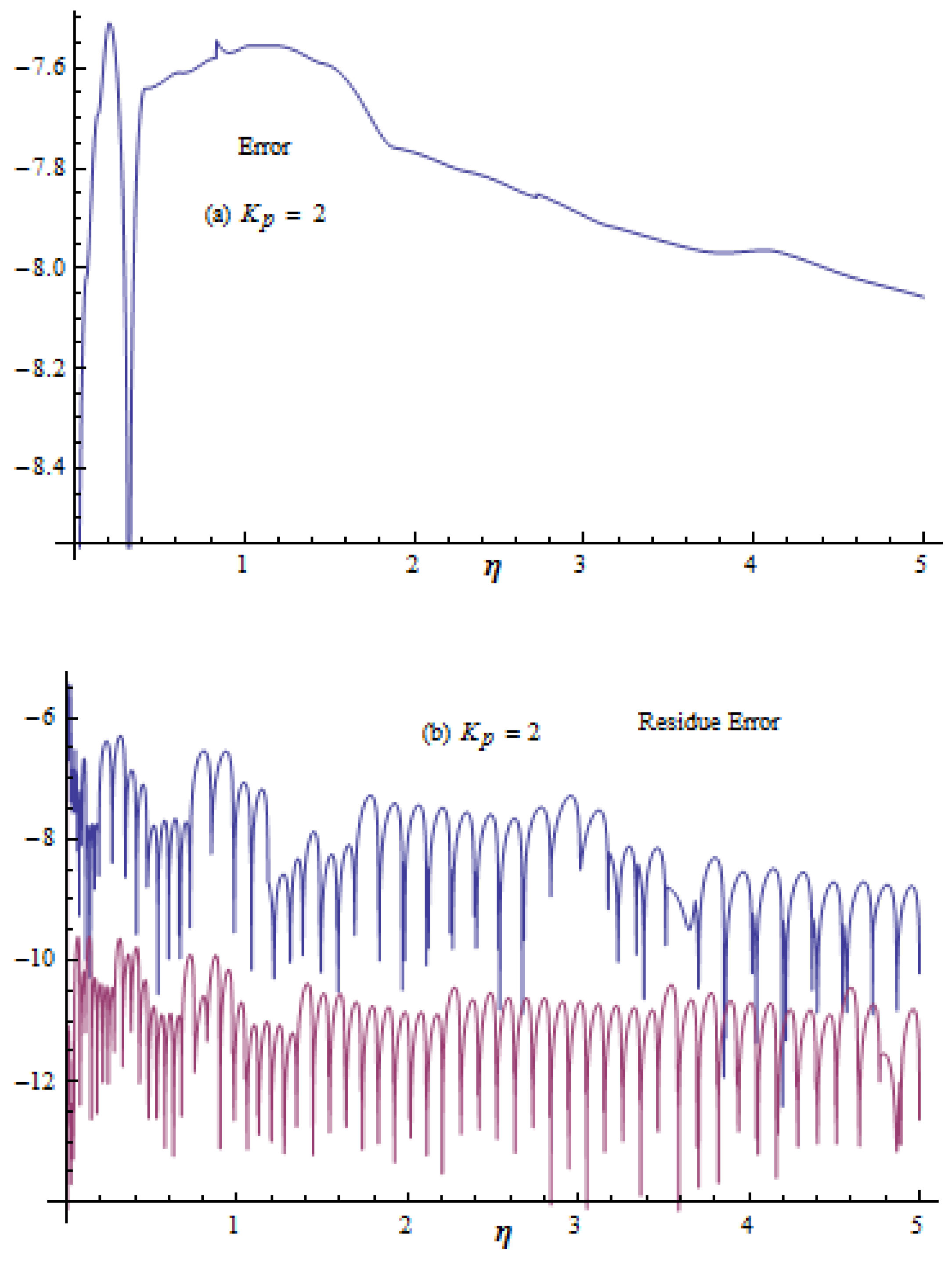
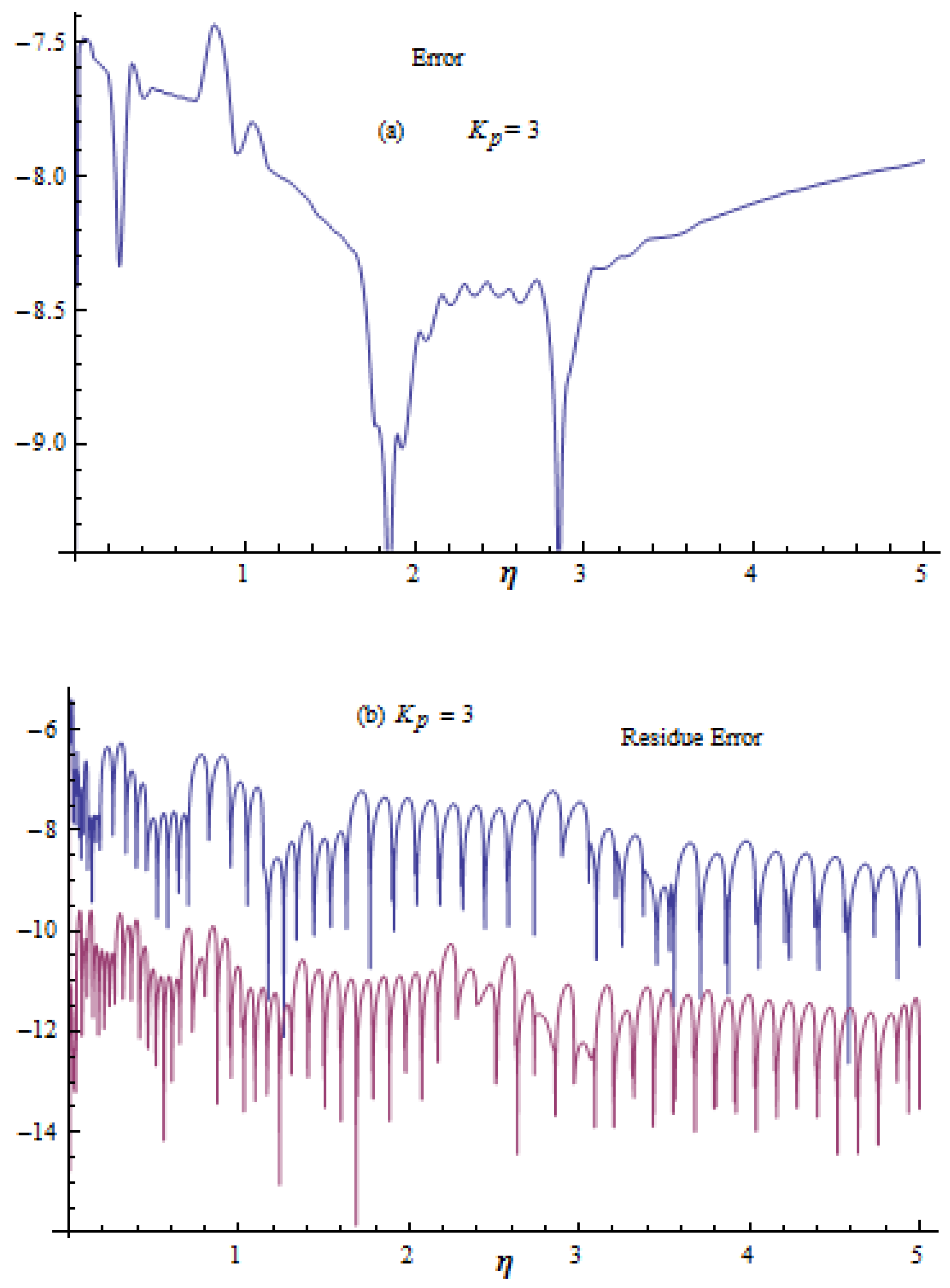



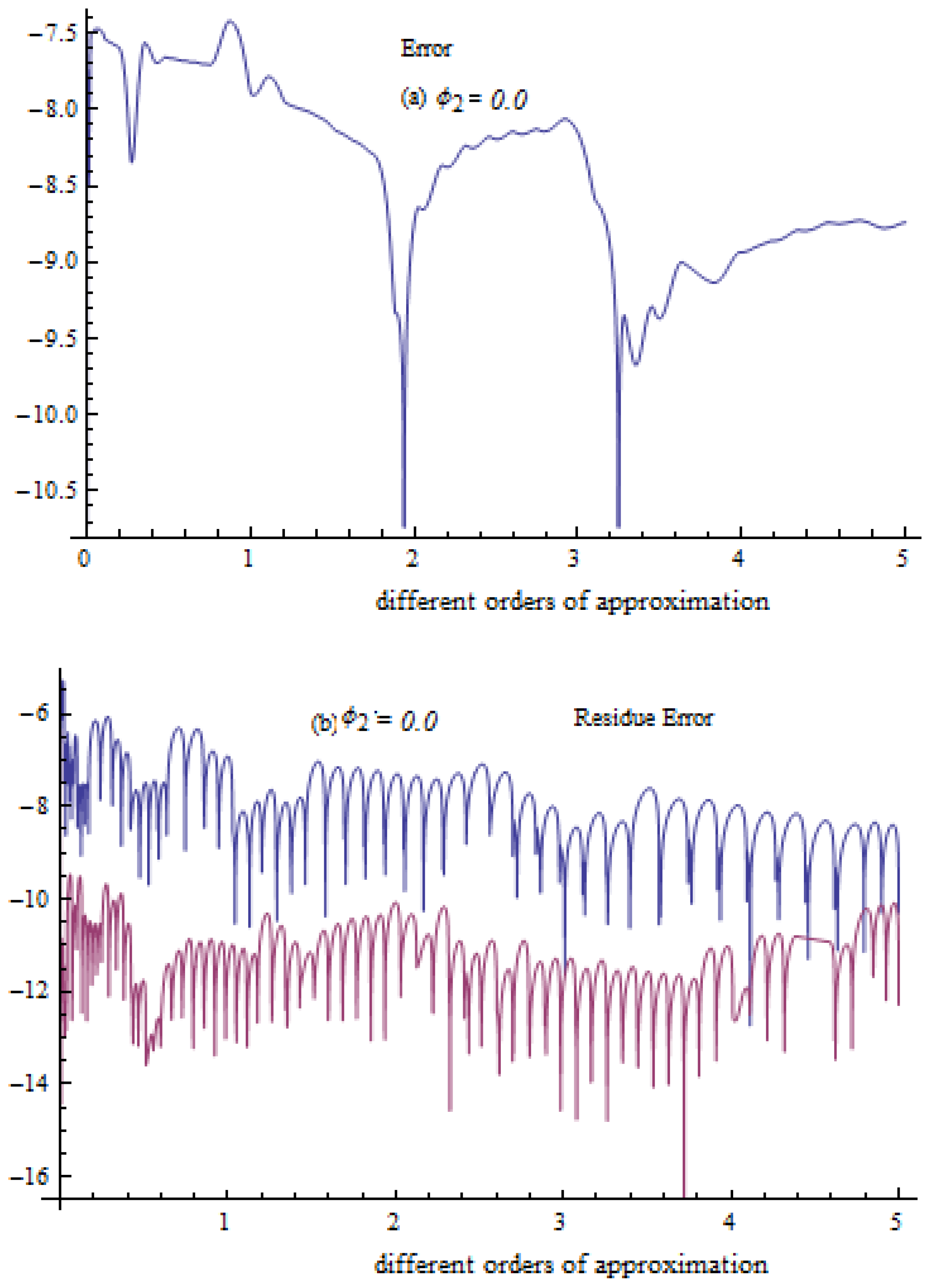
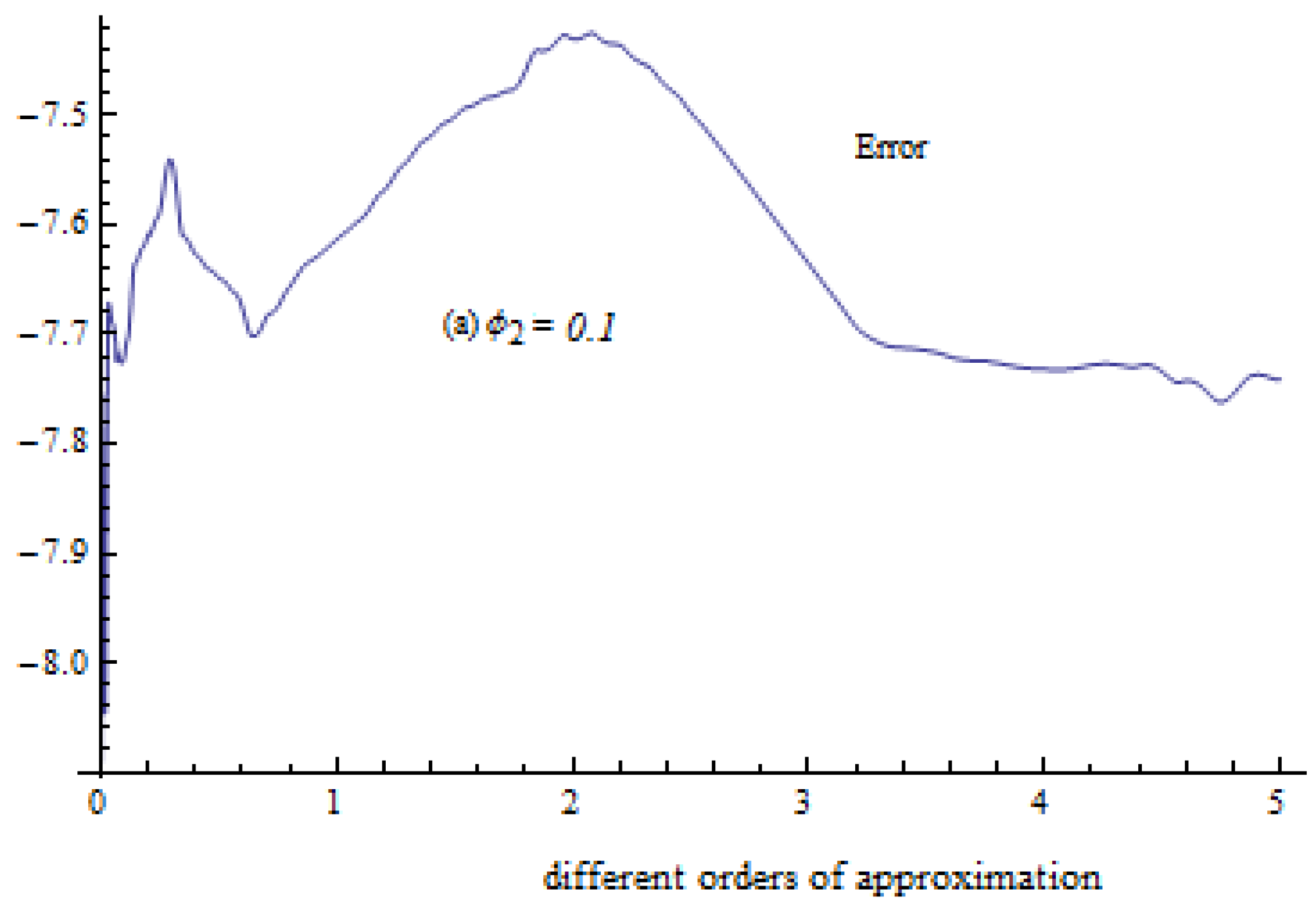
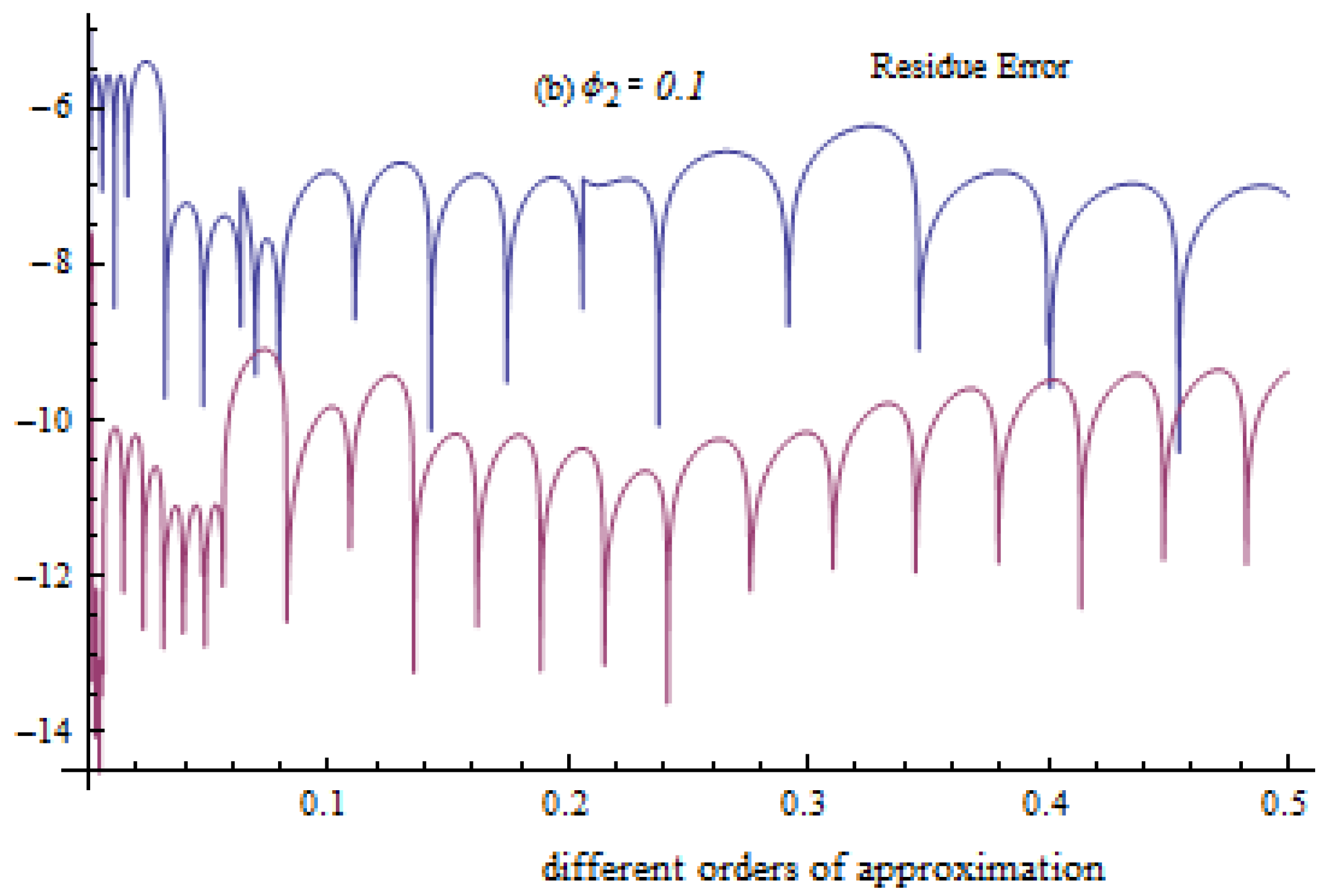
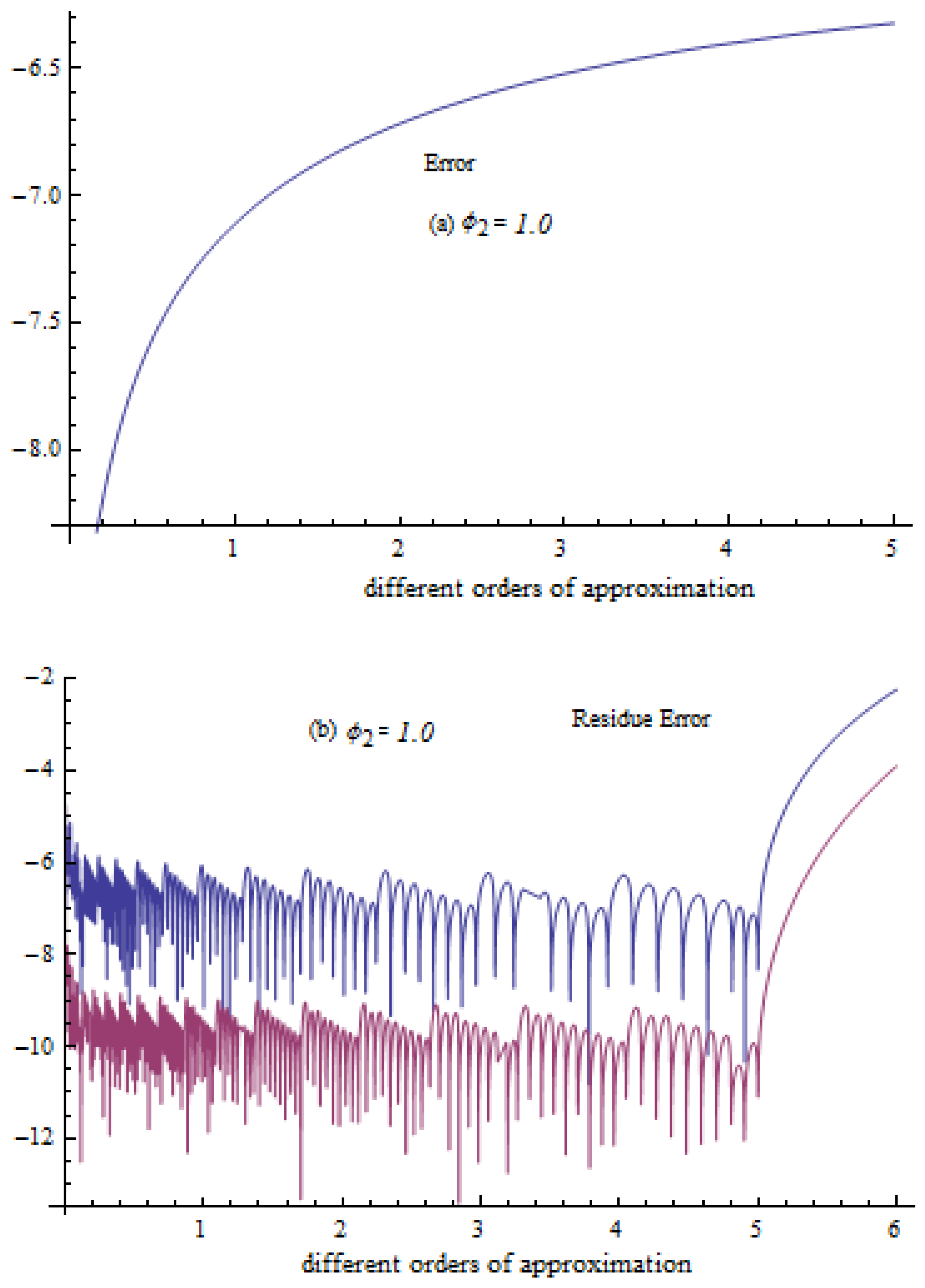
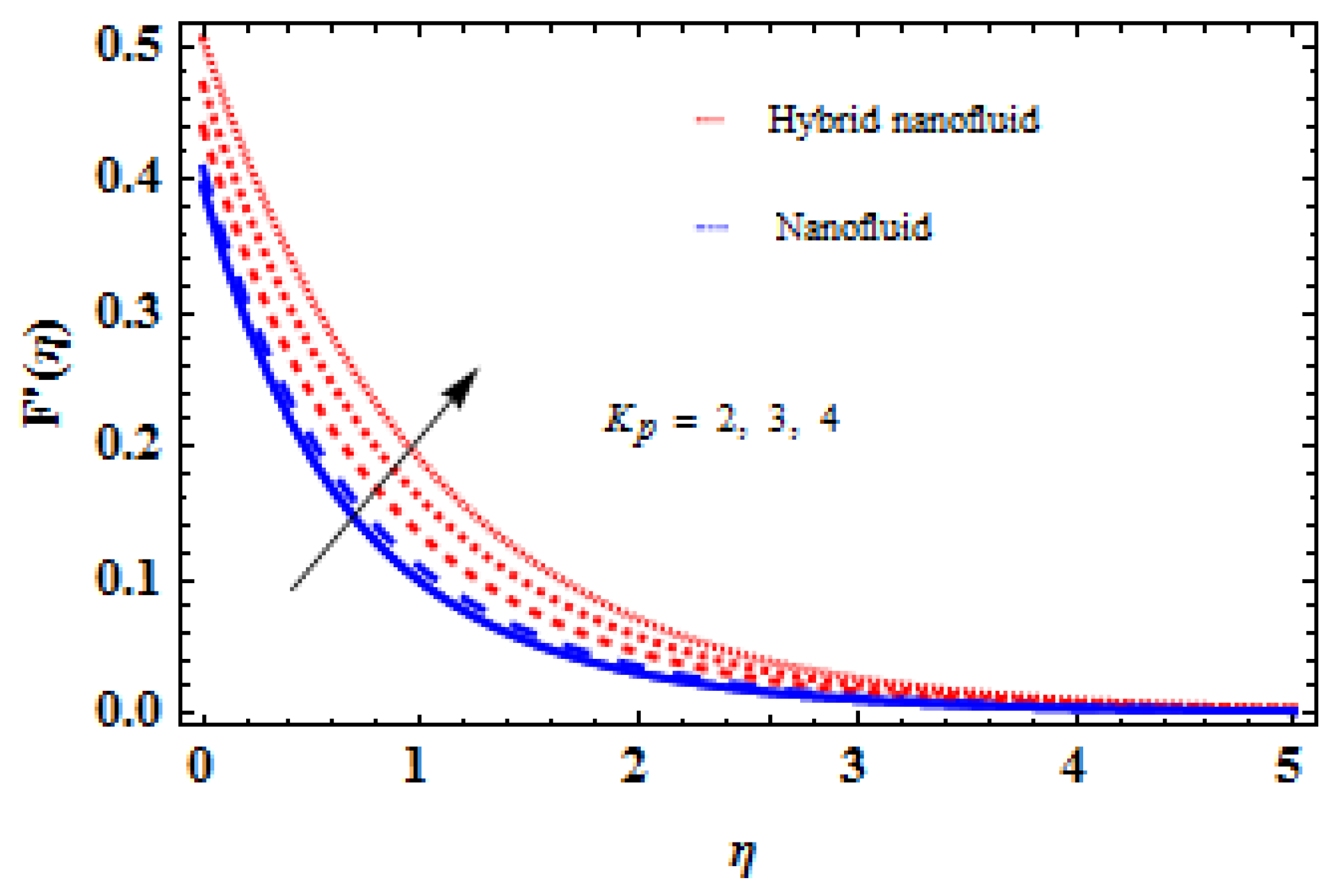
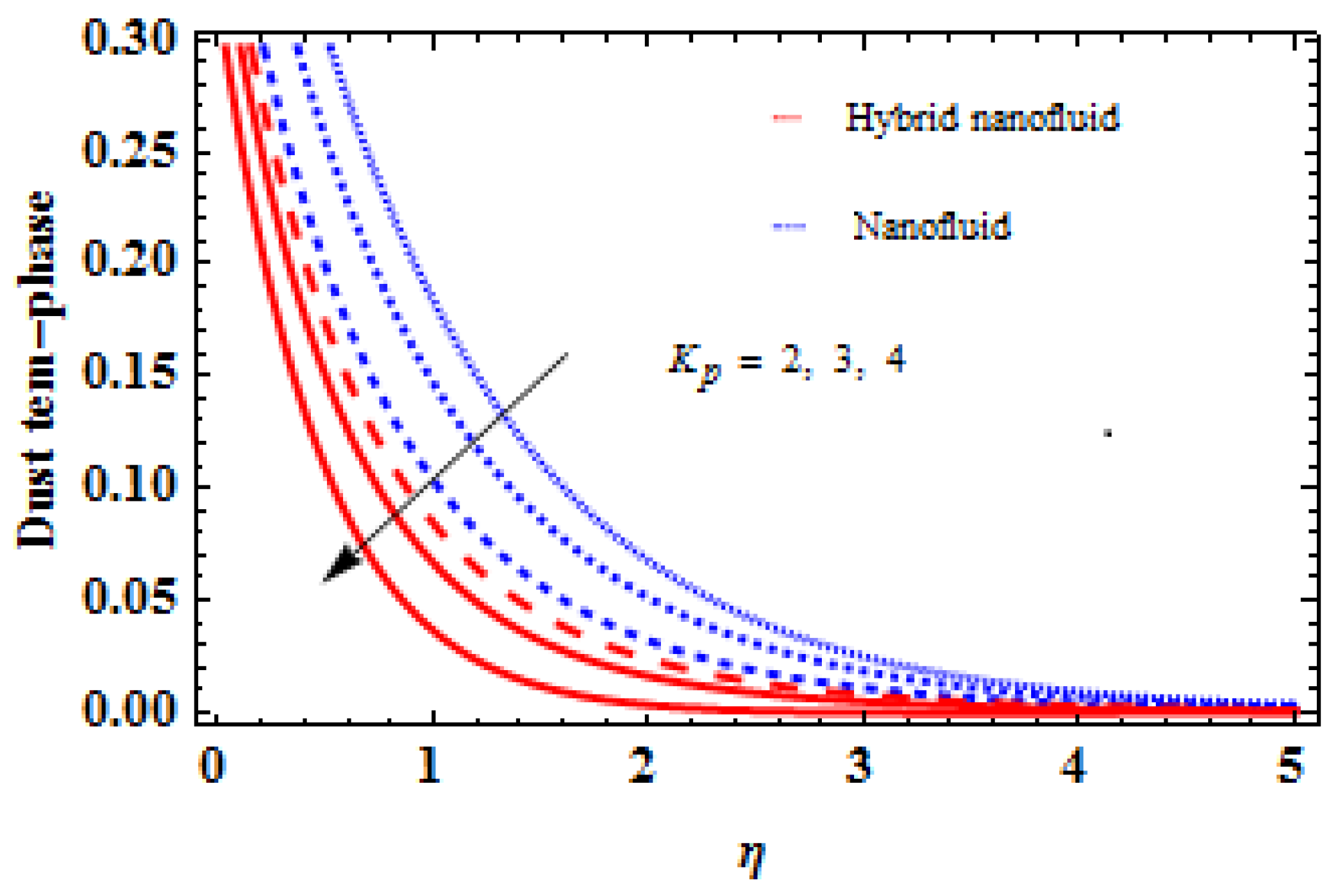
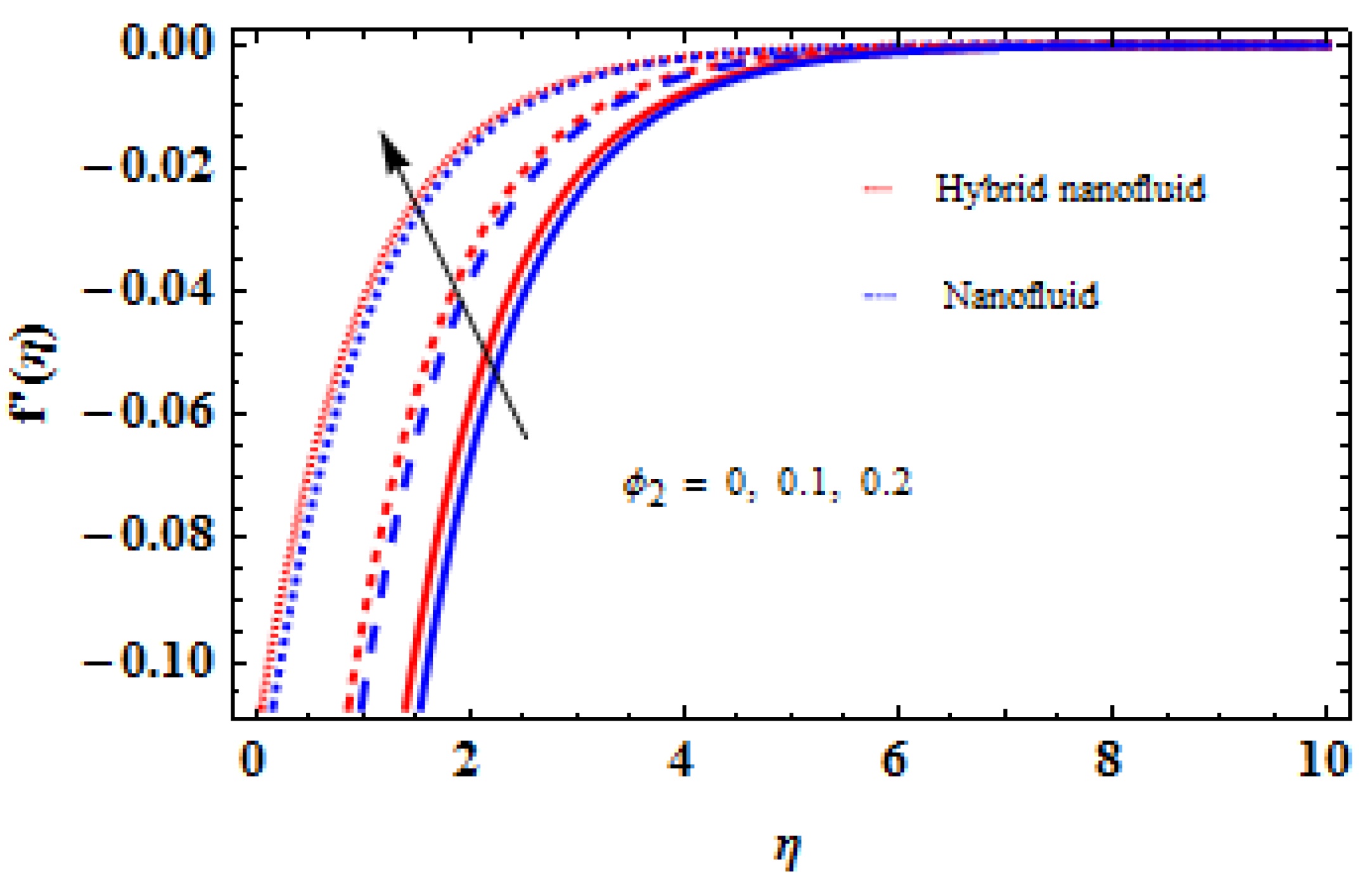
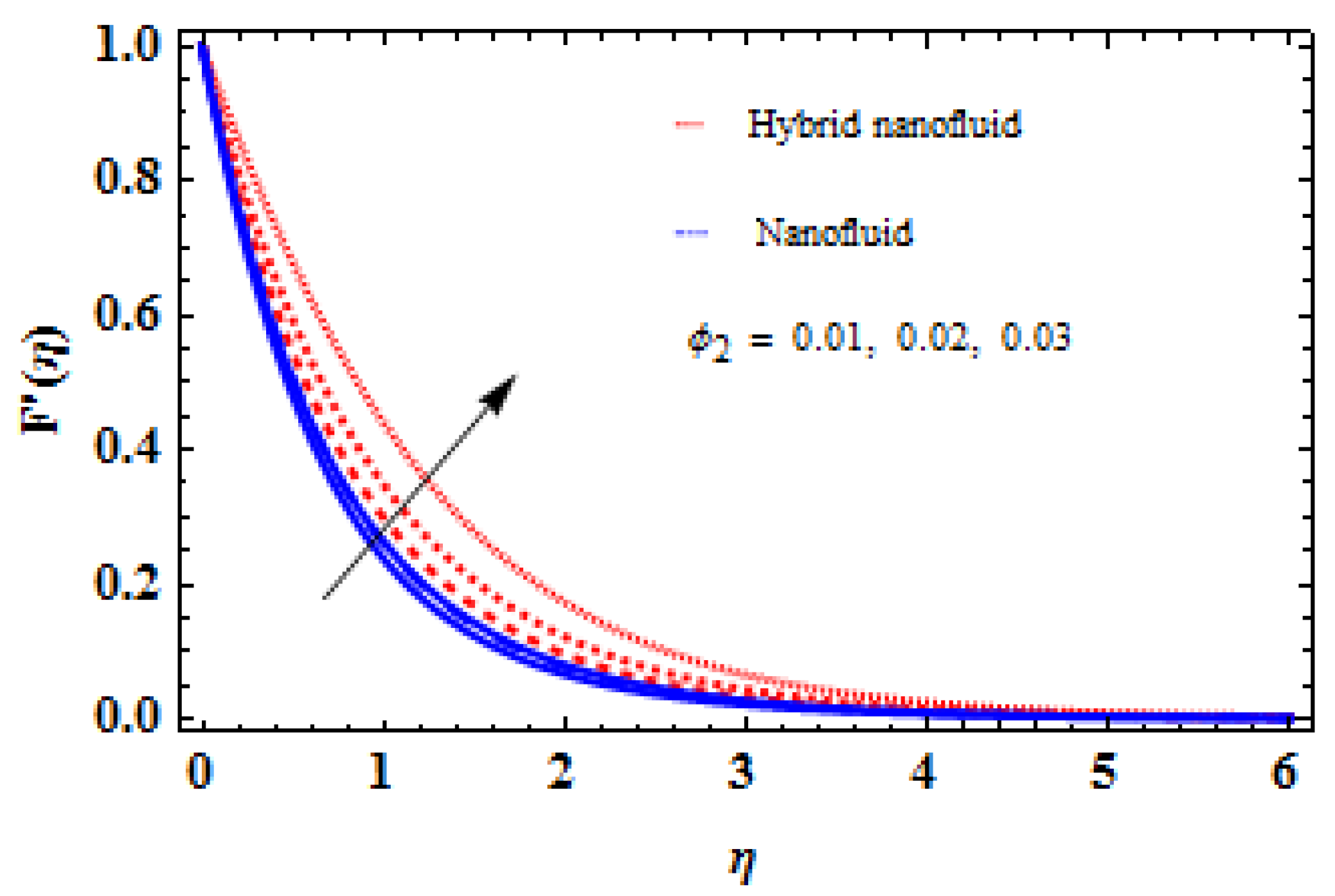
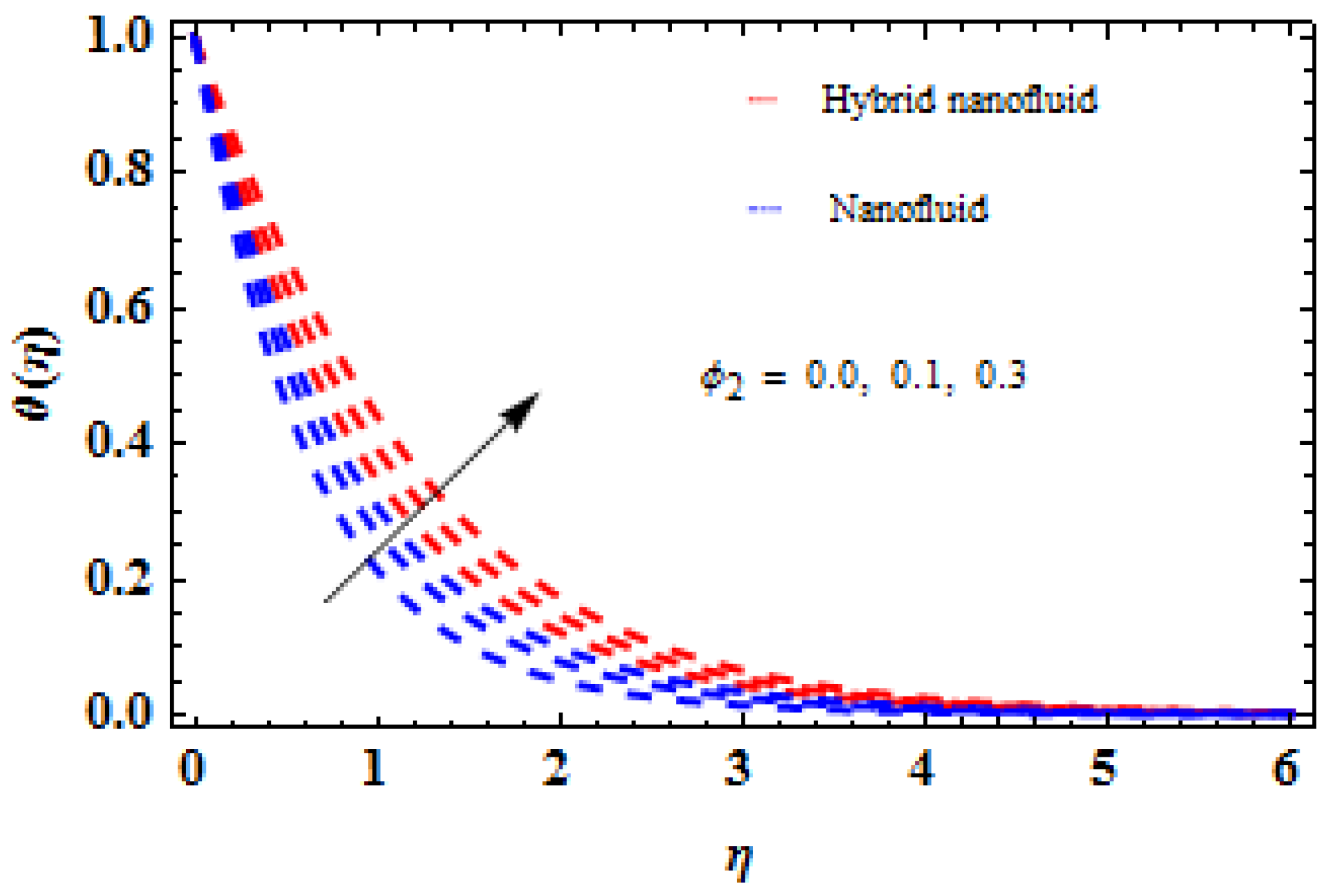
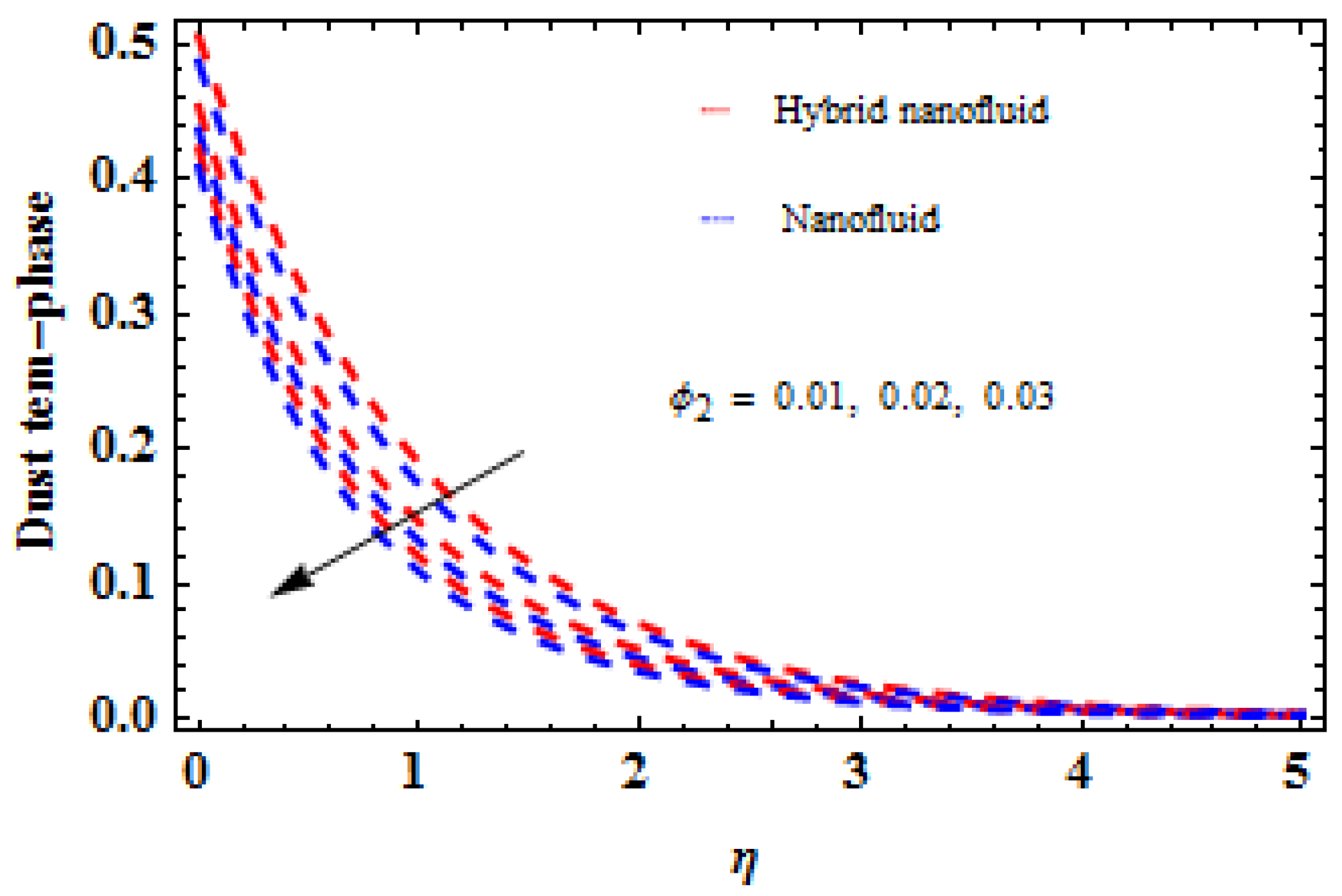
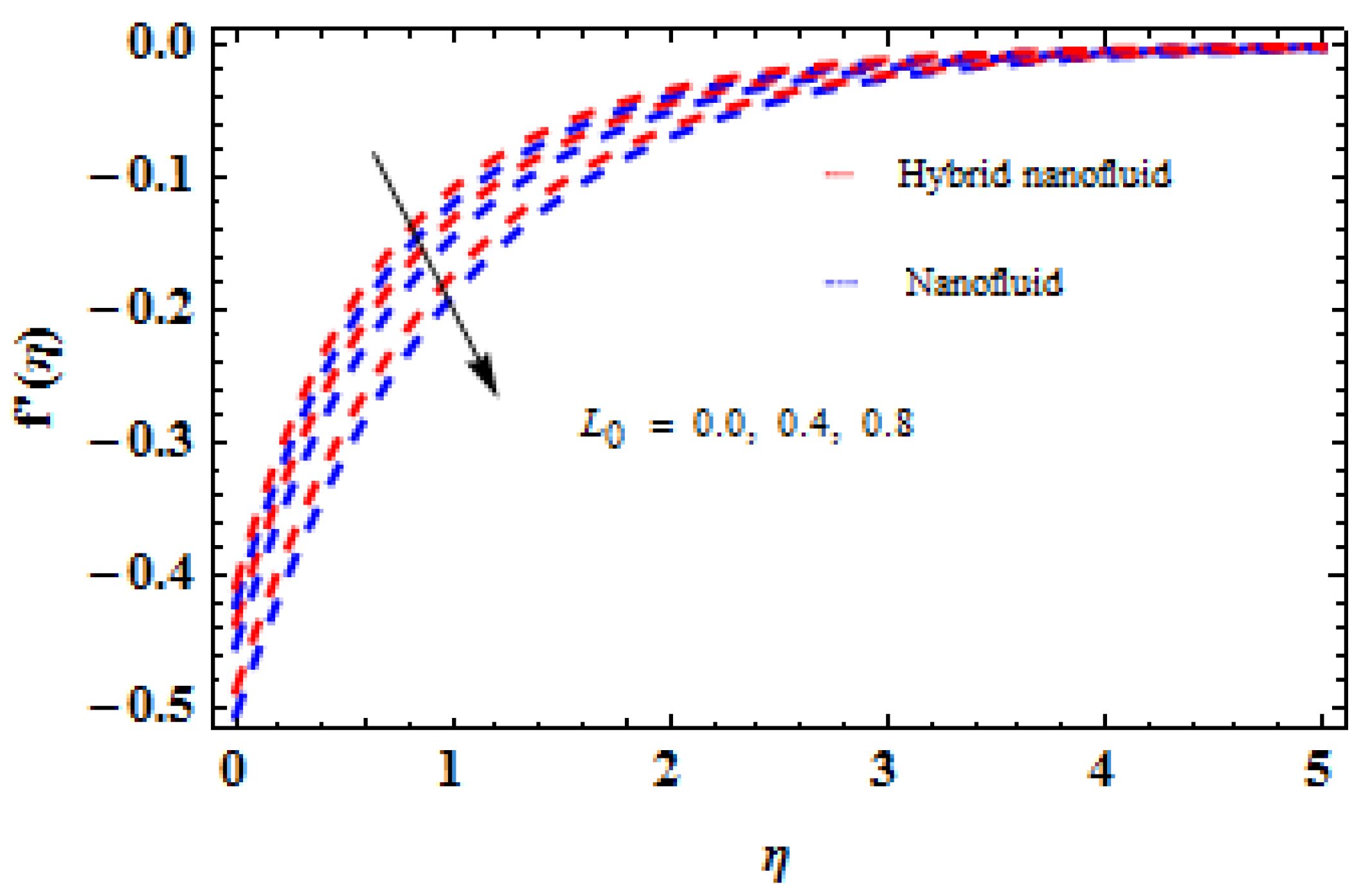

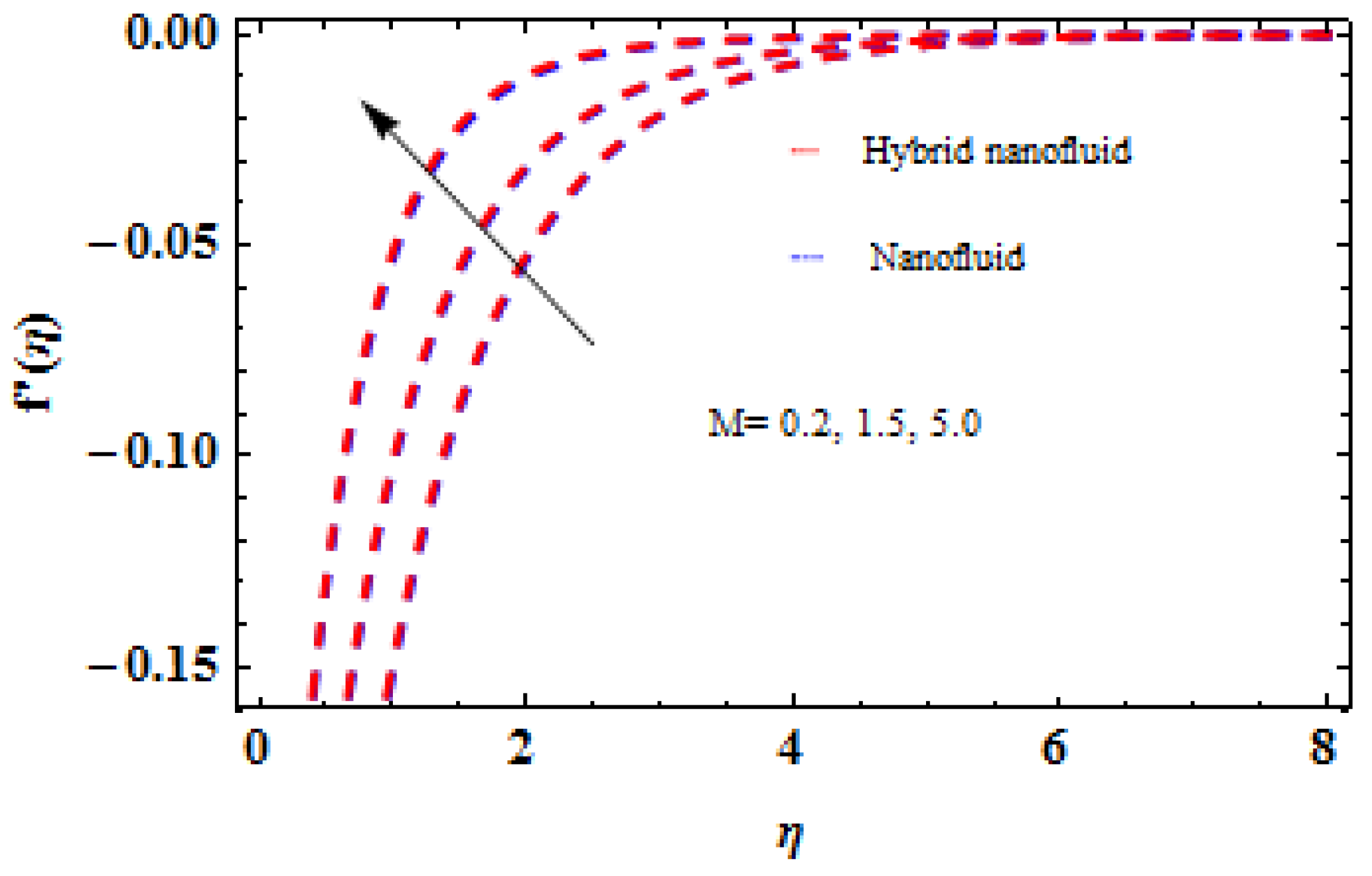

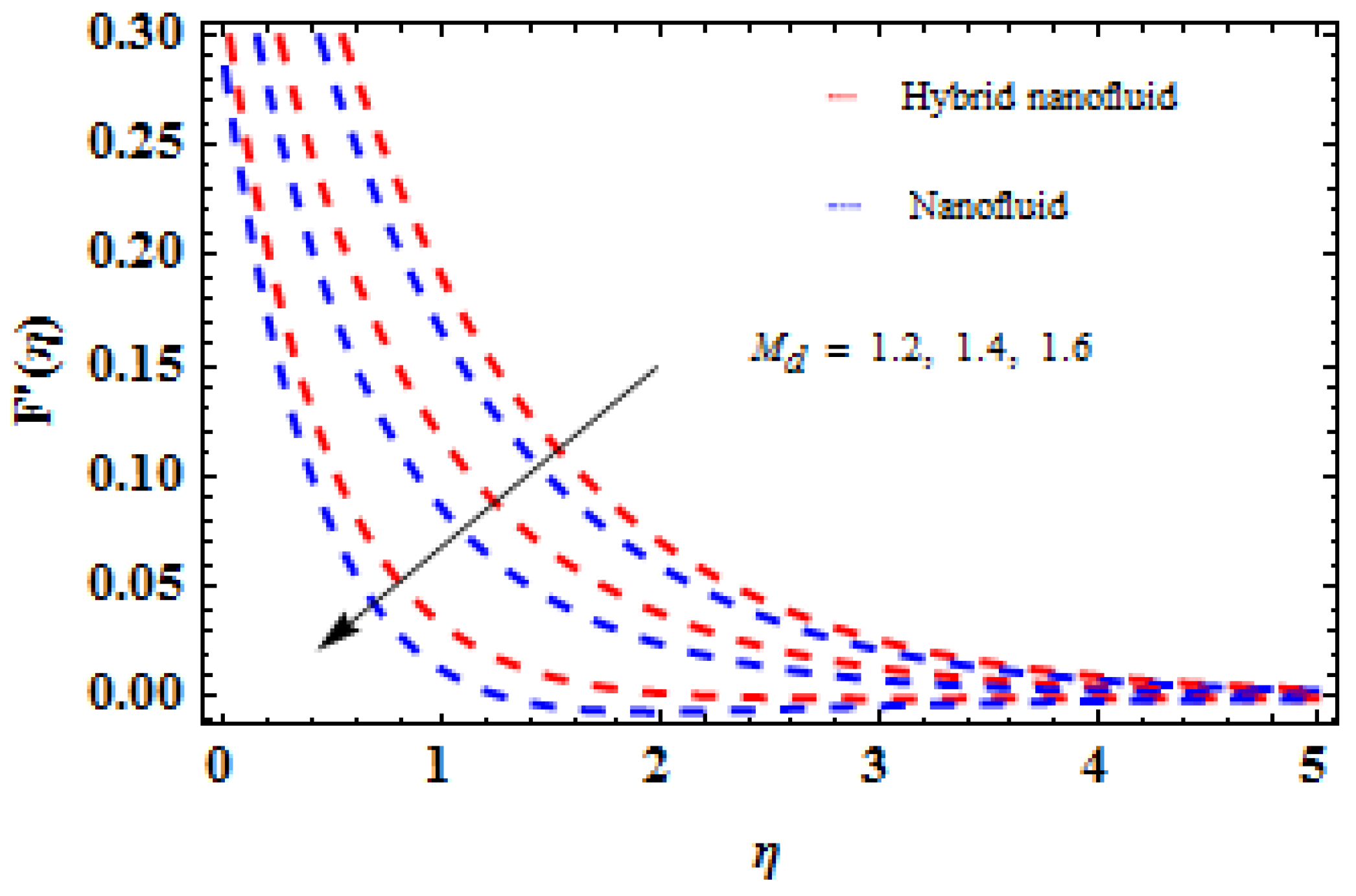
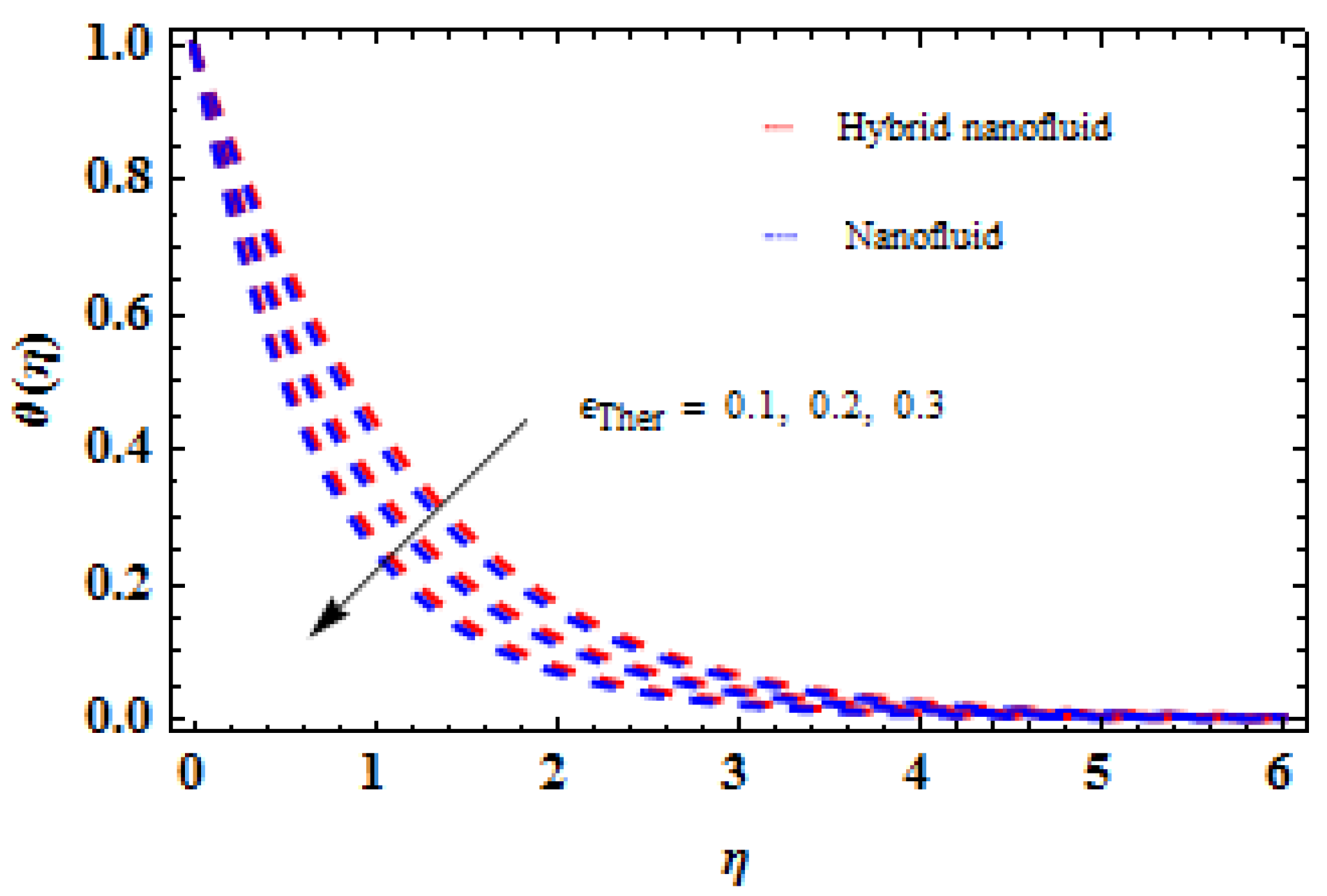


| Base Fluid/Nanomaterial | (J/kg K) | )z | K (W/mK) |
|---|---|---|---|
| C2H6O2 | 2430 | 1115 | 0.253 |
| CuO | 531.8 | 6320.0 | 76.5 |
| Cu | 385 | 8933 | 401 |
| Present Work | Published Work [45] | Relative Error (%) | |
|---|---|---|---|
| 5 | 1.418911 | 1.418910 | 0.2 10−5 |
| 10 | 1.346602 | 1.346600 | 0.6 107 |
| 20 | 1.313613 | 1.313610 | 1.1 10−9 |
| 30 | 1.302801 | 1.302800 | 3.02 10−11 |
| 50 | 1.297512 | 1.297510 | 5.2 10−13 |
| 15 | 1.294402 | 1.294410 | 1.7 10−16 |
| 20 | 1.288104 | 1.288100 | 0.9 10−21 |
| Skin Friction | ||
|---|---|---|
| Nanofluid | Hybrid nanofluid | |
| 0.1 | 0.62711 | 0.68294 |
| 0.3 | 0.68324 | 0.74782 |
| 0.5 | 0.75485 | 0.83164 |
| Skin Friction | ||
| Nanofluid | Hybrid nanofluid | |
| 0.1 | 0.53744 | 0.58389 |
| 0.3 | 0.56885 | 0.61826 |
| 0.5 | 0.59326 | 0.65572 |
| Skin Friction | ||
| Nanofluid | Hybrid nanofluid | |
| 0.2 | 1.29731 | 1.49161 |
| 0.4 | 0.79299 | 0.87499 |
| 0.8 | 0.5344 | 0.58389 |
| Skin Friction | ||
| Nanofluid | Hybrid nanofluid | |
| 1 | 0.79558 | 0.89749 |
| 2 | 0.93826 | 0.91633 |
| 3 | 0.93799 | 0.99629 |
| Skin Friction | ||
| Nanofluid | Hybrid nanofluid | |
| 2 | 0.45851 | 0.49471 |
| 4 | 0.42724 | 0.43335 |
| 6 | 0.42638 | 0.42775 |
Disclaimer/Publisher’s Note: The statements, opinions and data contained in all publications are solely those of the individual author(s) and contributor(s) and not of MDPI and/or the editor(s). MDPI and/or the editor(s) disclaim responsibility for any injury to people or property resulting from any ideas, methods, instructions or products referred to in the content. |
© 2023 by the authors. Licensee MDPI, Basel, Switzerland. This article is an open access article distributed under the terms and conditions of the Creative Commons Attribution (CC BY) license (https://creativecommons.org/licenses/by/4.0/).
Share and Cite
Zeeshan; Ahammad, N.A.; Shah, N.A.; Chung, J.D. Role of Nanofluid and Hybrid Nanofluid for Enhancing Thermal Conductivity towards Exponentially Stretching Curve with Modified Fourier Law Inspired by Melting Heat Effect. Mathematics 2023, 11, 1170. https://doi.org/10.3390/math11051170
Zeeshan, Ahammad NA, Shah NA, Chung JD. Role of Nanofluid and Hybrid Nanofluid for Enhancing Thermal Conductivity towards Exponentially Stretching Curve with Modified Fourier Law Inspired by Melting Heat Effect. Mathematics. 2023; 11(5):1170. https://doi.org/10.3390/math11051170
Chicago/Turabian StyleZeeshan, N. Ameer Ahammad, Nehad Ali Shah, and Jae Dong Chung. 2023. "Role of Nanofluid and Hybrid Nanofluid for Enhancing Thermal Conductivity towards Exponentially Stretching Curve with Modified Fourier Law Inspired by Melting Heat Effect" Mathematics 11, no. 5: 1170. https://doi.org/10.3390/math11051170
APA StyleZeeshan, Ahammad, N. A., Shah, N. A., & Chung, J. D. (2023). Role of Nanofluid and Hybrid Nanofluid for Enhancing Thermal Conductivity towards Exponentially Stretching Curve with Modified Fourier Law Inspired by Melting Heat Effect. Mathematics, 11(5), 1170. https://doi.org/10.3390/math11051170







